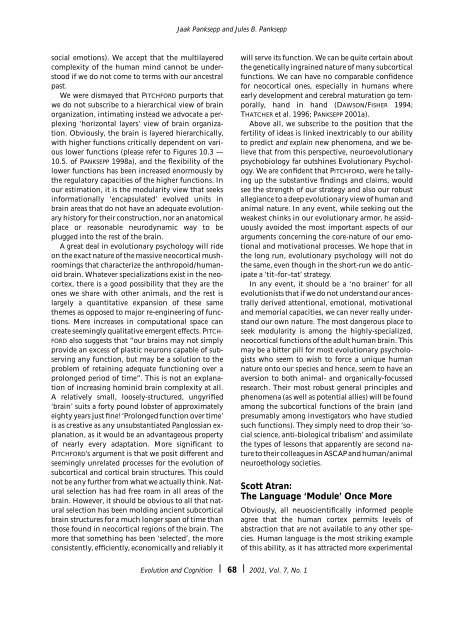The Seven Sins of Evolutionary Psychology - Konrad Lorenz Institute
The Seven Sins of Evolutionary Psychology - Konrad Lorenz Institute
The Seven Sins of Evolutionary Psychology - Konrad Lorenz Institute
Create successful ePaper yourself
Turn your PDF publications into a flip-book with our unique Google optimized e-Paper software.
Jaak Panksepp and Jules B. Pankseppsocial emotions). We accept that the multilayeredcomplexity <strong>of</strong> the human mind cannot be understoodif we do not come to terms with our ancestralpast.We were dismayed that PITCHFORD purports thatwe do not subscribe to a hierarchical view <strong>of</strong> brainorganization, intimating instead we advocate a perplexing‘horizontal layers’ view <strong>of</strong> brain organization.Obviously, the brain is layered hierarchically,with higher functions critically dependent on variouslower functions (please refer to Figures 10.3 —10.5. <strong>of</strong> PANKSEPP 1998a), and the flexibility <strong>of</strong> thelower functions has been increased enormously bythe regulatory capacities <strong>of</strong> the higher functions. Inour estimation, it is the modularity view that seeksinformationally ‘encapsulated’ evolved units inbrain areas that do not have an adequate evolutionaryhistory for their construction, nor an anatomicalplace or reasonable neurodynamic way to beplugged into the rest <strong>of</strong> the brain.A great deal in evolutionary psychology will rideon the exact nature <strong>of</strong> the massive neocortical mushroomingsthat characterize the anthropoid/humanoidbrain. Whatever specializations exist in the neocortex,there is a good possibility that they are theones we share with other animals, and the rest islargely a quantitative expansion <strong>of</strong> these samethemes as opposed to major re-engineering <strong>of</strong> functions.Mere increases in computational space cancreate seemingly qualitative emergent effects. PITCH-FORD also suggests that “our brains may not simplyprovide an excess <strong>of</strong> plastic neurons capable <strong>of</strong> subservingany function, but may be a solution to theproblem <strong>of</strong> retaining adequate functioning over aprolonged period <strong>of</strong> time”. This is not an explanation<strong>of</strong> increasing hominid brain complexity at all.A relatively small, loosely-structured, ungyrified‘brain’ suits a forty pound lobster <strong>of</strong> approximatelyeighty years just fine! ‘Prolonged function over time’is as creative as any unsubstantiated Panglossian explanation,as it would be an advantageous property<strong>of</strong> nearly every adaptation. More significant toPITCHFORD’s argument is that we posit different andseemingly unrelated processes for the evolution <strong>of</strong>subcortical and cortical brain structures. This couldnot be any further from what we actually think. Naturalselection has had free roam in all areas <strong>of</strong> thebrain. However, it should be obvious to all that naturalselection has been molding ancient subcorticalbrain structures for a much longer span <strong>of</strong> time thanthose found in neocortical regions <strong>of</strong> the brain. <strong>The</strong>more that something has been ‘selected’, the moreconsistently, efficiently, economically and reliably itwill serve its function. We can be quite certain aboutthe genetically ingrained nature <strong>of</strong> many subcorticalfunctions. We can have no comparable confidencefor neocortical ones, especially in humans whereearly development and cerebral maturation go temporally,hand in hand (DAWSON/FISHER 1994;THATCHER et al. 1996; PANKSEPP 2001a).Above all, we subscribe to the position that thefertility <strong>of</strong> ideas is linked inextricably to our abilityto predict and explain new phenomena, and we believethat from this perspective, neuroevolutionarypsychobiology far outshines <strong>Evolutionary</strong> <strong>Psychology</strong>.We are confident that PITCHFORD, were he tallyingup the substantive findings and claims, wouldsee the strength <strong>of</strong> our strategy and also our robustallegiance to a deep evolutionary view <strong>of</strong> human andanimal nature. In any event, while seeking out theweakest chinks in our evolutionary armor, he assiduouslyavoided the most important aspects <strong>of</strong> ourarguments concerning the core-nature <strong>of</strong> our emotionaland motivational processes. We hope that inthe long run, evolutionary psychology will not dothe same, even though in the short-run we do anticipatea ‘tit–for–tat’ strategy.In any event, it should be a ‘no brainer’ for allevolutionists that if we do not understand our ancestrallyderived attentional, emotional, motivationaland memorial capacities, we can never really understandour own nature. <strong>The</strong> most dangerous place toseek modularity is among the highly-specialized,neocortical functions <strong>of</strong> the adult human brain. Thismay be a bitter pill for most evolutionary psychologistswho seem to wish to force a unique humannature onto our species and hence, seem to have anaversion to both animal- and organically-focussedresearch. <strong>The</strong>ir most robust general principles andphenomena (as well as potential allies) will be foundamong the subcortical functions <strong>of</strong> the brain (andpresumably among investigators who have studiedsuch functions). <strong>The</strong>y simply need to drop their ‘socialscience, anti-biological tribalism’ and assimilatethe types <strong>of</strong> lessons that apparently are second natureto their colleagues in ASCAP and human/animalneuroethology societies.Scott Atran:<strong>The</strong> Language ‘Module’ Once MoreObviously, all neuoscientifically informed peopleagree that the human cortex permits levels <strong>of</strong>abstraction that are not available to any other species.Human language is the most striking example<strong>of</strong> this ability, as it has attracted more experimentalEvolution and Cognition ❘ 68 ❘ 2001, Vol. 7, No. 1








